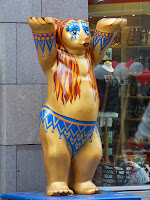 Well another Brno Thanksgiving has come and gone. This is my favorite time of year. I really feel that, to most Americans, Thanksgiving is more important than Christmas. With Thanksgiving it is all about being with family and friends and enjoying each others' company without all of the crazy commercialism. And I really like sharing it will all of my friends over here in Euroland.
Well another Brno Thanksgiving has come and gone. This is my favorite time of year. I really feel that, to most Americans, Thanksgiving is more important than Christmas. With Thanksgiving it is all about being with family and friends and enjoying each others' company without all of the crazy commercialism. And I really like sharing it will all of my friends over here in Euroland. Rather than use the same turkey farm I've used the past two years, I special ordered the bird from a local halal shop. I planned on an 11 kg bird to easily feed 25 people. When we showed up to pick up the turkey we were told that all they had for us was a 14 kg (31 lb) turkey. I wasn't sure if this Frankenturkey would even fit in to my oven. Whew! Just barely.
Rather than use the same turkey farm I've used the past two years, I special ordered the bird from a local halal shop. I planned on an 11 kg bird to easily feed 25 people. When we showed up to pick up the turkey we were told that all they had for us was a 14 kg (31 lb) turkey. I wasn't sure if this Frankenturkey would even fit in to my oven. Whew! Just barely.Of course, Thanksgiving here would not have been possible without help from the US. Thanks again to my mom for sending over a few key supplies. And a big thanks to Steven and Michael!! They brought me aluminum turkey pans when we met up in Paris this year. These disposable pans just aren't available over here. The pans have a 9 kg (20 lb) capacity so I was pushing it with a 14 kg bird. Fortunately it worked out fine and after 8.5 hours in the oven we were ready to eat.
 I also had help this year with some of the prep work. Kamila came over on Friday and made all of the pie crusts. She also baked her very first red velvet cake. Claudia brought over her delicious pumpkin soup and Miran helped with peeling potatoes, carrots and he made the deviled eggs. It's amazing how just a little bit of help can make such a difference. I was able to get to sleep on Friday before midnight which was nice since I had to prep the bird at 4:30 AM.
I also had help this year with some of the prep work. Kamila came over on Friday and made all of the pie crusts. She also baked her very first red velvet cake. Claudia brought over her delicious pumpkin soup and Miran helped with peeling potatoes, carrots and he made the deviled eggs. It's amazing how just a little bit of help can make such a difference. I was able to get to sleep on Friday before midnight which was nice since I had to prep the bird at 4:30 AM. Anyway, we had all of the traditional fixings and then some; turkey, dressing, pumpkin soup, sweet potato casserole, mac 'n cheese, mashed potatoes and gravy, cranberry sauce, green bean casserole, broccoli and rice casserole, corn bread muffins with honey butter, spinach dip, deviled eggs, glazed carrots, pecan pie, Bundt cake, cherry cake, red velvet cake, and Prekmurska gibanica. Yum!! And definitely lots of leftovers for the office on Monday.
Anyway, we had all of the traditional fixings and then some; turkey, dressing, pumpkin soup, sweet potato casserole, mac 'n cheese, mashed potatoes and gravy, cranberry sauce, green bean casserole, broccoli and rice casserole, corn bread muffins with honey butter, spinach dip, deviled eggs, glazed carrots, pecan pie, Bundt cake, cherry cake, red velvet cake, and Prekmurska gibanica. Yum!! And definitely lots of leftovers for the office on Monday. It's always fun introducing people to Thanksgiving because some of our dishes are just unheard of over here. People are always surprised by sweet potatoes topped with marshmallows.
It's always fun introducing people to Thanksgiving because some of our dishes are just unheard of over here. People are always surprised by sweet potatoes topped with marshmallows.  But they are always one of the first things that we run out of and I always have requests for the recipe.
But they are always one of the first things that we run out of and I always have requests for the recipe. Afterwards we were so full we could barely move. After the "turkey coma" had worn off and the alcohol had kicked in we headed off to the Brno Christmas market.
Afterwards we were so full we could barely move. After the "turkey coma" had worn off and the alcohol had kicked in we headed off to the Brno Christmas market. Thanks again to everyone who helped make this such a great time.











































































